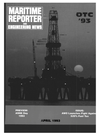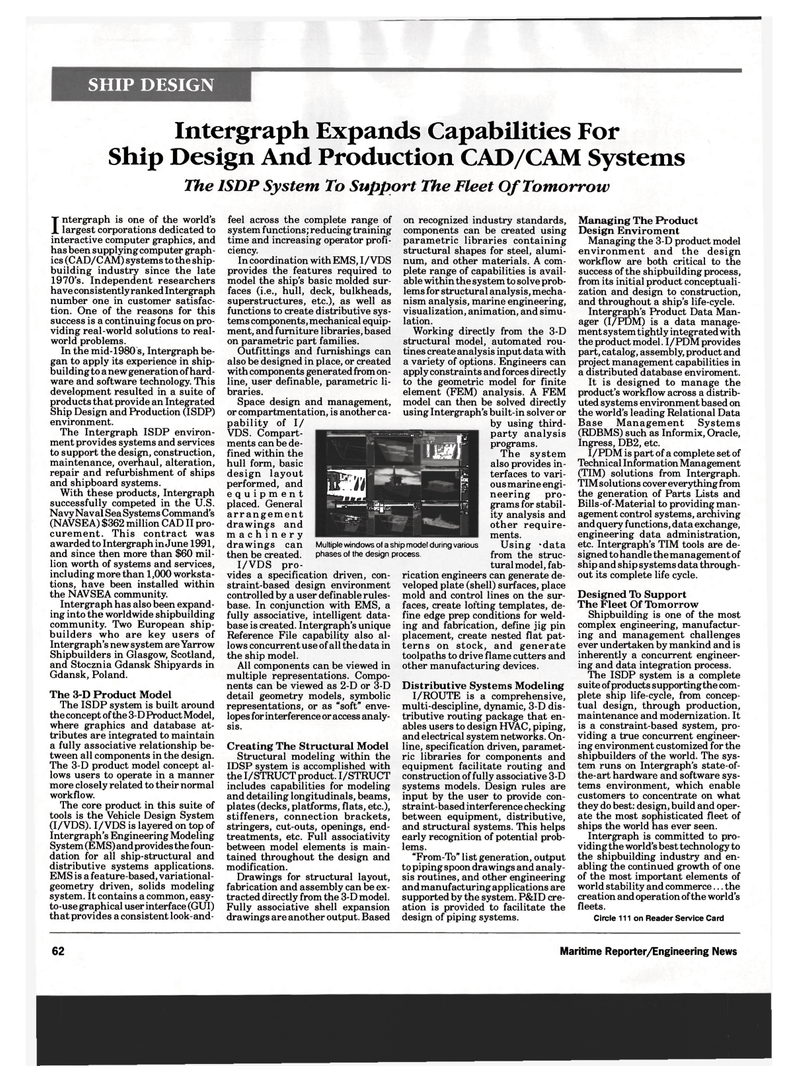
Page 60: of Maritime Reporter Magazine (April 1993)
Read this page in Pdf, Flash or Html5 edition of April 1993 Maritime Reporter Magazine
SHIP DESIGN
Intergraph Expands Capabilities For
Ship Design And Production CAD/CAM Systems
The ISDP System To Support The Fleet Of Tomorrow
Intergraph is one of the world's largest corporations dedicated to interactive computer graphics, and has been supplying computer graph- ics (CAD/CAM) systems to the ship- building industry since the late 1970's. Independent researchers have consistently ranked Intergraph number one in customer satisfac- tion. One of the reasons for this success is a continuing focus on pro- viding real-world solutions to real- world problems.
In the mid-1980s, Intergraph be- gan to apply its experience in ship- buildingto anew generation of hard- ware and software technology. This development resulted in a suite of products that provide an Integrated
Ship Design and Production (ISDP) environment.
The Intergraph ISDP environ- ment provides systems and services to support the design, construction, maintenance, overhaul, alteration, repair and refurbishment of ships and shipboard systems.
With these products, Intergraph successfully competed in the U.S.
Navy Naval Sea Systems Command's (NAVSEA) $362 million CAD II pro- curement. This contract was awarded to Intergraph in June 1991, and since then more than $60 mil- lion worth of systems and services, including more than 1,000 worksta- tions, have been installed within the NAVSEA community.
Intergraph has also been expand- ing into the worldwide shipbuilding community. Two European ship- builders who are key users of
Intergr aph's new system are Yarrow
Shipbuilders in Glasgow, Scotland, and Stocznia Gdansk Shipyards in
Gdansk, Poland.
The 3-D Product Model
The ISDP system is built around the concept of the 3-D Product Model, where graphics and database at- tributes are integrated to maintain a fully associative relationship be- tween all components in the design.
The 3-D product model concept al- lows users to operate in a manner more closely related to their normal workflow.
The core product in this suite of tools is the Vehicle Design System (I/VDS). I/VDS is layered on top of
Intergraph's Engineering Modeling
System (EMS) and provides the foun- dation for all ship-structural and distributive systems applications.
EMS is a feature-based, variational- geometry driven, solids modeling system. It contains a common, easy- to-use graphical user interface (GUI) that provides a consistent look-and- feel across the complete range of system functions; reducing training time and increasing operator profi- ciency.
Incoordination with EMS, I/VDS provides the features required to model the ship's basic molded sur- faces (i.e., hull, deck, bulkheads, superstructures, etc.), as well as functions to create distributive sys- tems components, mechanical equip- ment, and furniture libraries, based on parametric part families.
Outfittings and furnishings can also be designed in place, or created with components generated from on- line, user definable, parametric li- braries.
Space design and management, or compartmentation, is another ca- pability of 1/
VDS. Compart- ments can be de- fined within the hull form, basic design layout performed, and equipment placed. General arrangement drawings and machinery drawings can then be created.
I/VDS pro- vides a specification driven, con- straint-based design environment controlled by a user definable rules- base. In conjunction with EMS, a fully associative, intelligent data- base is created. Intergraph's unique
Reference File capability also al- lows concurrent use of all the data in the ship model.
All components can be viewed in multiple representations. Compo- nents can be viewed as 2-D or 3-D detail geometry models, symbolic representations, or as "soft" enve- lopes for interference or access analy- sis.
Creating The Structural Model
Structural modeling within the
IDSP system is accomplished with the I/STRUCT product. I/STRUCT includes capabilities for modeling and detailing longitudinals, beams, plates (decks, platforms, flats, etc.), stiffeners, connection brackets, stringers, cut-outs, openings, end- treatments, etc. Full associativity between model elements is main- tained throughout the design and modification.
Drawings for structural layout, fabrication and assembly can be ex- tracted directly from the 3-D model.
Fully associative shell expansion drawings are another output. Based - HI iM i
L op m ••• ~r l "^SjjjijrJ tiljB "V:
I"1
Multiple windows of a ship model during various phases of the design process. on recognized industry standards, components can be created using parametric libraries containing structural shapes for steel, alumi- num, and other materials. A com- plete range of capabilities is avail- able within the system to solve prob- lems for structural analysis, mecha- nism analysis, marine engineering, visualization, animation, and simu- lation.
Working directly from the 3-D structural model, automated rou- tines create analysis input data with a variety of options. Engineers can apply constraints and forces directly to the geometric model for finite element (FEM) analysis. A FEM model can then be solved directly using Intergraph's built-in solver or by using third- party analysis programs.
The system also provides in- terfaces to vari- ous marine engi- neering pro- grams for stabil- ity analysis and other require- ments.
Using -data from the struc- tural model, fab- rication engineers can generate de- veloped plate (shell) surfaces, place mold and control lines on the sur- faces, create lofting templates, de- fine edge prep conditions for weld- ing and fabrication, define jig pin placement, create nested flat pat- terns on stock, and generate toolpaths to drive flame cutters and other manufacturing devices.
Distributive Systems Modeling
I/ROUTE is a comprehensive, multi-descipline, dynamic, 3-D dis- tributive routing package that en- ables users to design HVAC, piping, and electrical system networks. On- line, specification driven, paramet- ric libraries for components and equipment facilitate routing and construction of fully associative 3-D systems models. Design rules are input by the user to provide con- straint-based interference checking between equipment, distributive, and structural systems. This helps early recognition of potential prob- lems. "From-To" list generation, output to piping spoon drawings and analy- sis routines, and other engineering and manufacturing applications are supported by the system. P&ID cre- ation is provided to facilitate the design of piping systems.
Managing The Product
Design Enviroment
Managing the 3-D product model environment and the design workflow are both critical to the success of the shipbuilding process, from its initial product conceptuali- zation and design to construction, and throughout a ship's life-cycle.
Intergraph's Product Data Man- ager (I/PDM) is a data manage- ment system tightly integrated with the product model. I/PDM provides part, catalog, assembly, product and project management capabilities in a distributed database enviroment.
It is designed to manage the product's workflow across a distrib- uted systems environment based on the world's leading Relational Data
Base Management Systems (RDBMS) such as Informix, Oracle,
Ingress, DB2, etc.
I/PDM is part of a complete set of
Technical Information Management (TIM) solutions from Intergraph.
TIM solutions cover everything from the generation of Parts Lists and
Bills-of-Material to providing man- agement control systems, archiving and query functions, data exchange, engineering data administration, etc. Intergraph's TIM tools are de- signed to handle the management of ship and ship systems data through- out its complete life cycle.
Designed To Support
The Fleet Of Tomorrow
Shipbuilding is one of the most complex engineering, manufactur- ing and management challenges ever undertaken by mankind and is inherently a concurrent engineer- ing and data integration process.
The ISDP system is a complete suite of products supportingthe com- plete ship life-cycle, from concep- tual design, through production, maintenance and modernization. It is a constraint-based system, pro- viding a true concurrent engineer- ing environment customized for the shipbuilders of the world. The sys- tem runs on Intergraph's state-of- the-art hardware and software sys- tems environment, which enable customers to concentrate on what they do best: design, build and oper- ate the most sophisticated fleet of ships the world has ever seen.
Intergraph is committed to pro- viding the world's best technology to the shipbuilding industry and en- abling the continued growth of one of the most important elements of world stability and commerce... the creation and operation of the world's fleets.
Circle 111 on Reader Service Card 62 Maritime Reporter/Engineering News

 59
59

 61
61
